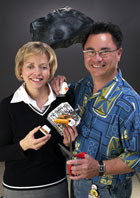|
When Deep Impact makes history in 2005, its mission should be well known to school children and adults. That's partly because of a 3-D paper model created at Ball Aerospace & Technologies Corp. Two Ball Aerospace employees with very different jobs developed the model kit. Denise Cook-Clampert is the education/public outreach (E/PO) coordinator and a technical writer. David Lewis is a graphic artist. David designed the model pieces. Denise wrote the instructions for building the model. Their combined talents led to the pattern that is available online for downloading and printing.
"Many NASA missions now include 3-D model kits as part of their education and public outreach (E/PO) efforts," said Denise. The plan for a paper model began when Dr. Lucy McFadden of the University of Maryland requested that Ball Aerospace elaborate on a prototype model design created by Bill Blume of the Jet Propulsion Laboratory. Lucy serves as both a Deep Impact co-investigator and the program's E/PO manager.
For David, building a model fits right in with his childhood interests. As a boy, he said he was always in the garage messing with his dad's tools. "I was the kid who always took stuff apart to see how it worked. I couldn't always figure out how to put it back together, though. So I'd take the parts and make them into something new and interesting."
At Ball Aerospace, David said he and the others who work in the company's Model Shop "build big toys from real drawings." "The challenge is to figure out how to create models and make them look the same as the real instruments and spacecraft, even though the materials used to make the models are different. As a kid, I wanted to see how things worked. Now, I have to figure out how to make things work." David had a great advantage when he began his work on the Deep Impact model. Ball Aerospace's Model Shop had already built two, 1/10th-scale Deep Impact models in 3-D. That meant all the full-size engineering drawings were at David's fingertips to aid his design. The paper model pattern designed by David is a 1/22nd-scale model so that it will fit on 8.5- x 11-inch paper. "I had to take the parts and decide how to fold them all together," explained David. Engineers working on Deep Impact were asked for their input, too. "I took certain items, such as the telescope and instrument, and gave them some dimension so that the paper model would look more like the real spacecraft," said David. Plus, he wanted to make the pattern at various skill levels. That's why the model comes in three versions.
The first version is simply the impactor, and the second version is the spacecraft with the impactor and telescopes pictured on it. Middle school students can build both of these. The third version is the most complex, with 3-D telescopes and a removable impactor. High school students and adults can build it in about 8 hours. David took great care to make sure the model looks like the real spacecraft and instruments. He spent time in the clean rooms at Ball Aerospace where Deep Impact was being built so that he could get the colors and shapes for the model just right. He also used the same assembly drawings that the real Deep Impact was made from so that all the scaling to size was accurate.
He and Denise had to consider several factors before determining how the model would be designed. Among the topics they discussed were:
- Who is the audience (what age-range is the model pattern for)?
- What degree of difficulty should the model design incorporate?
- How can the model pattern be drawn so that modelers can visualize the finished components from the unfolded pattern?
- What materials can be used that would be readily found in most households?
- How can the instructions be best written so that they are easy to follow?
As a technical writer, Denise worked carefully to make sure that the instructions were accurate and easy to understand. "I built my own Deep Impact model-the first model I'd ever made-as I wrote the instructions," she said. "My inexperience at model building made me even more aware of how important instructions are. They need to be simple and clear so that anyone can follow them. I also learned that I can actually build a fairly good paper model!"
Denise wants to instill an appreciation both for model building and for the Deep Impact mission itself. "We hope the model will engage people in the actual spacecraft and give them a better idea of its entirety," said Denise. She is a proponent of making these model patterns because they facilitate the public's understanding of the work done at Ball Aerospace. "Most people are not invited in to see what we do. A paper model can be the next best thing," she said. "David's done an excellent job of taking a complicated spacecraft-really two spacecraft-and making a detailed and realistic model. Best of all, it is one that even first-time model builders can make," said Denise.
Click here to download one of our model kits.












